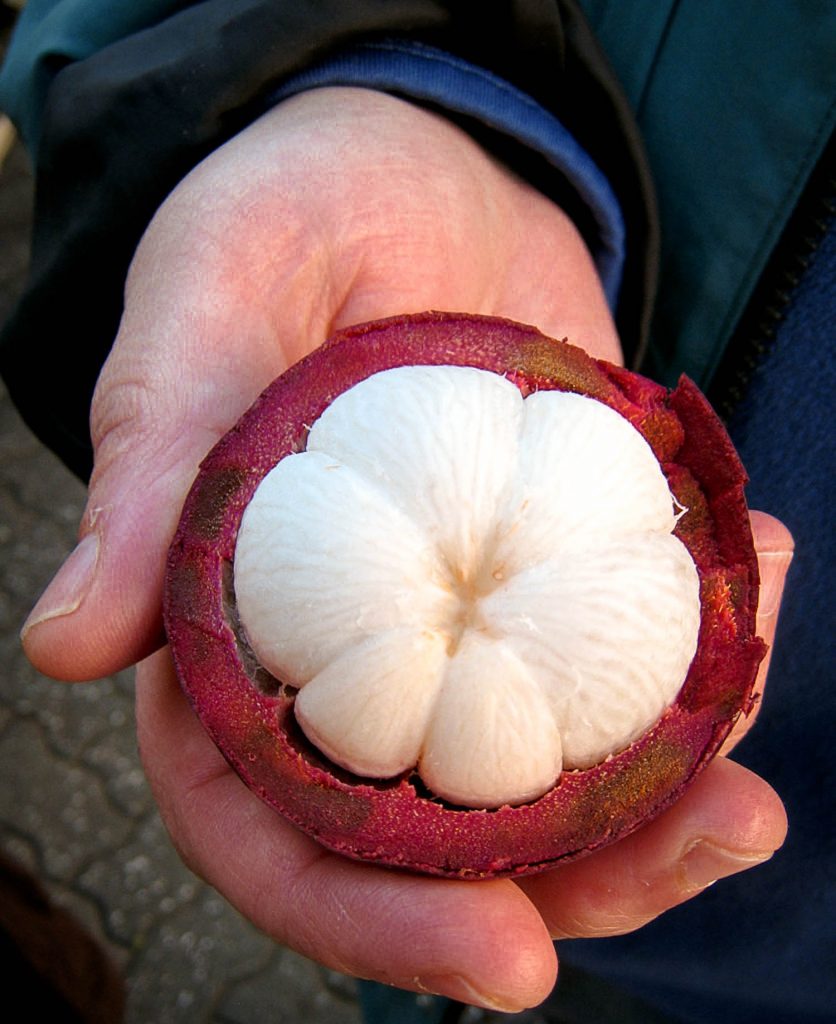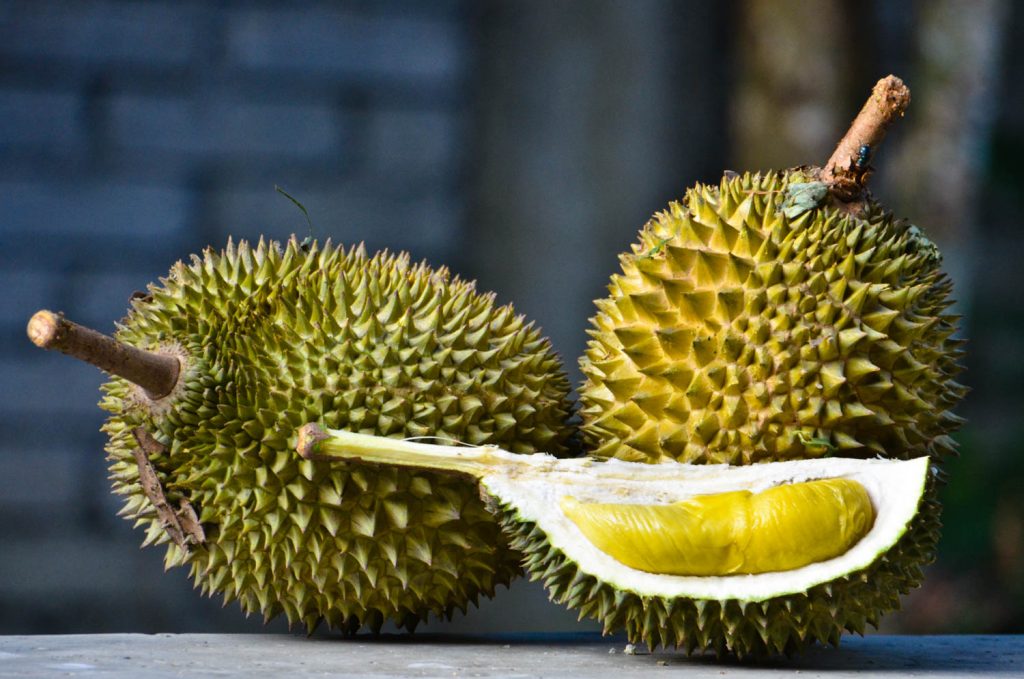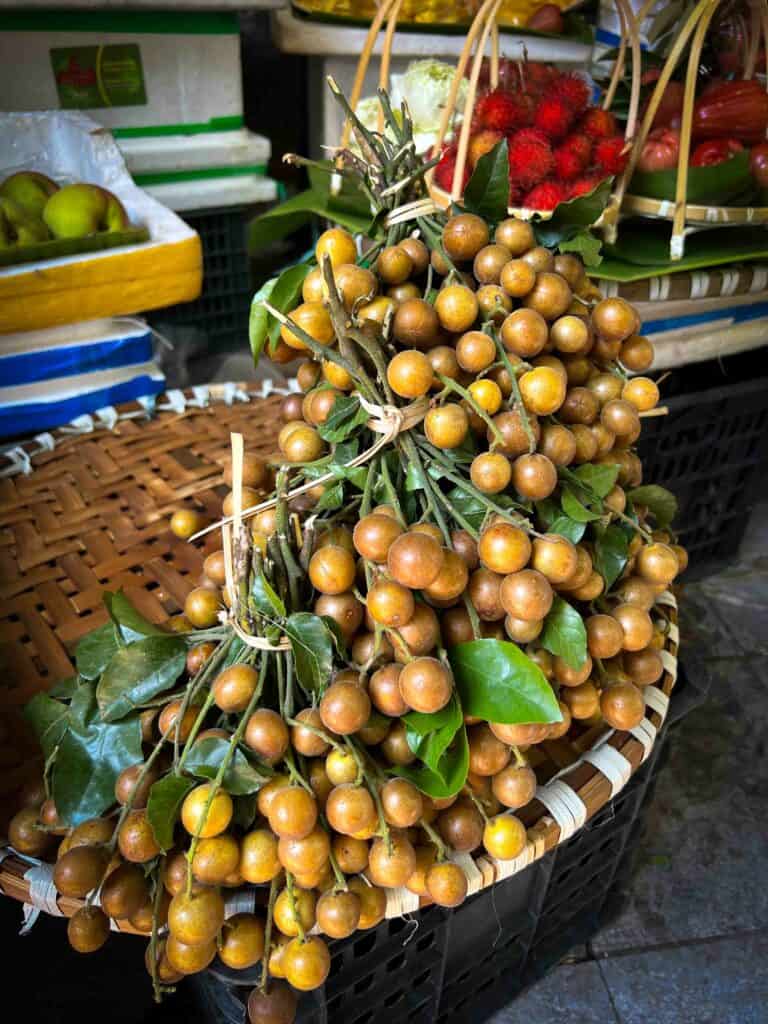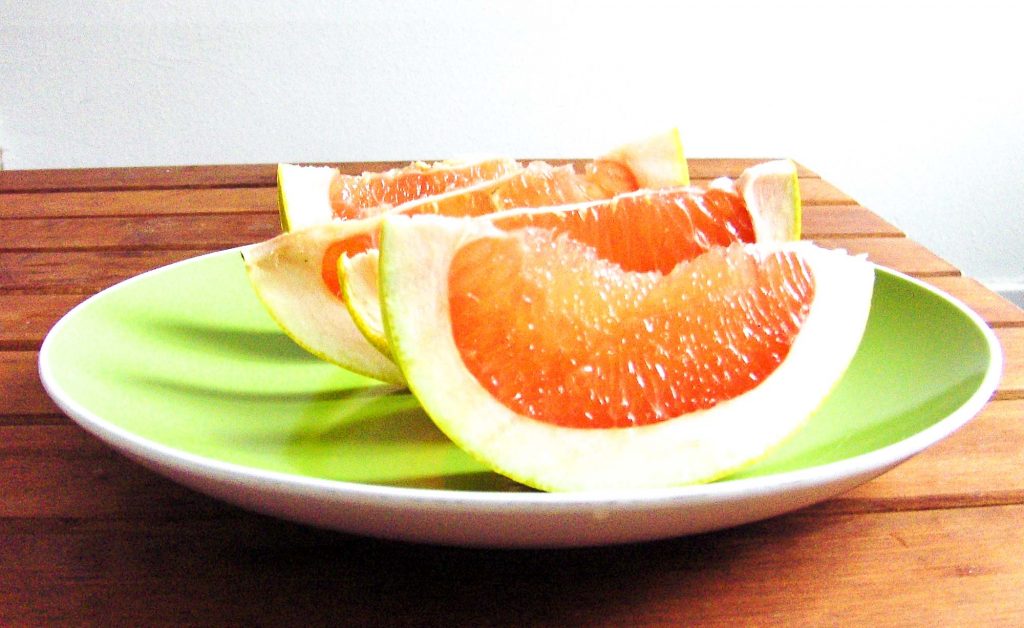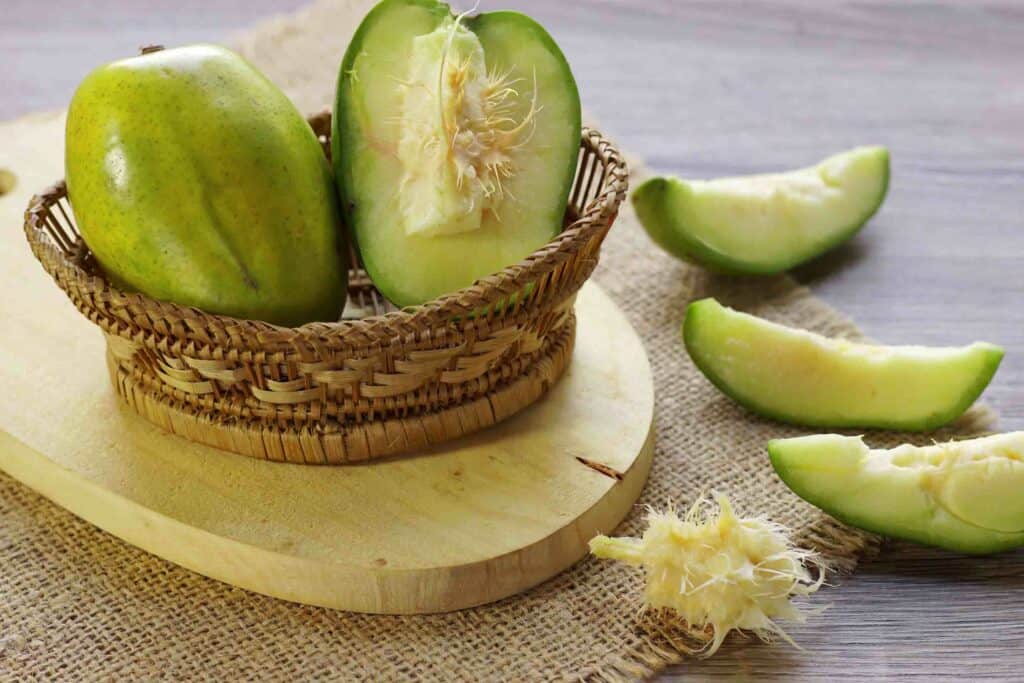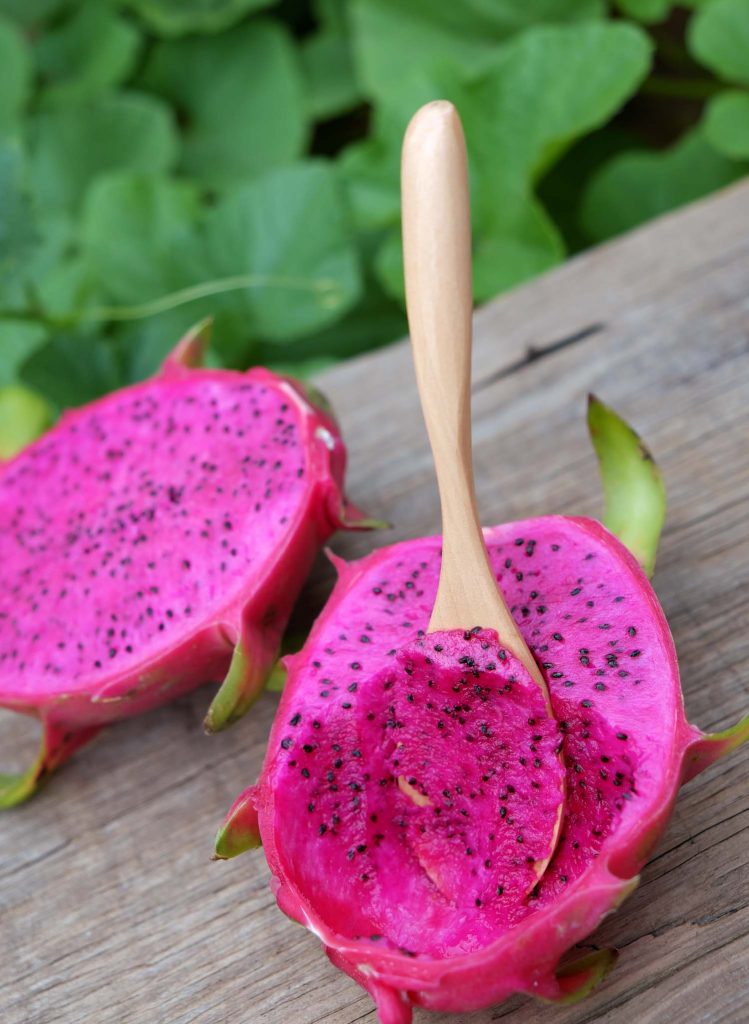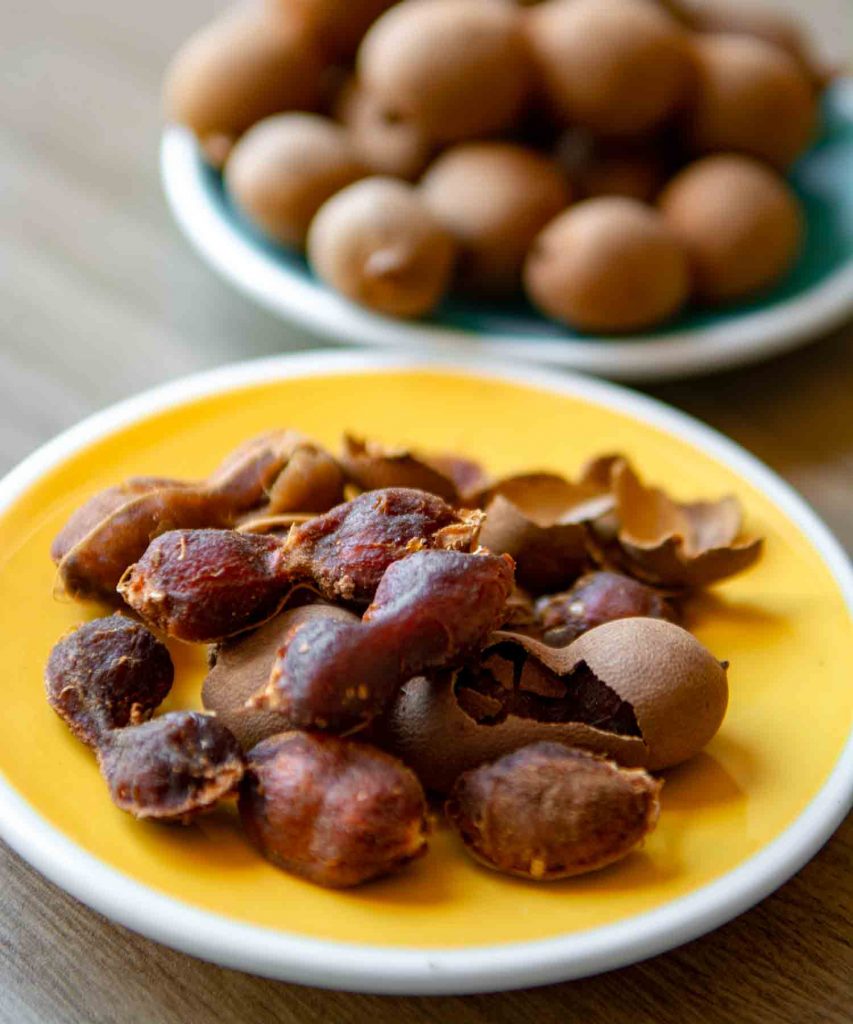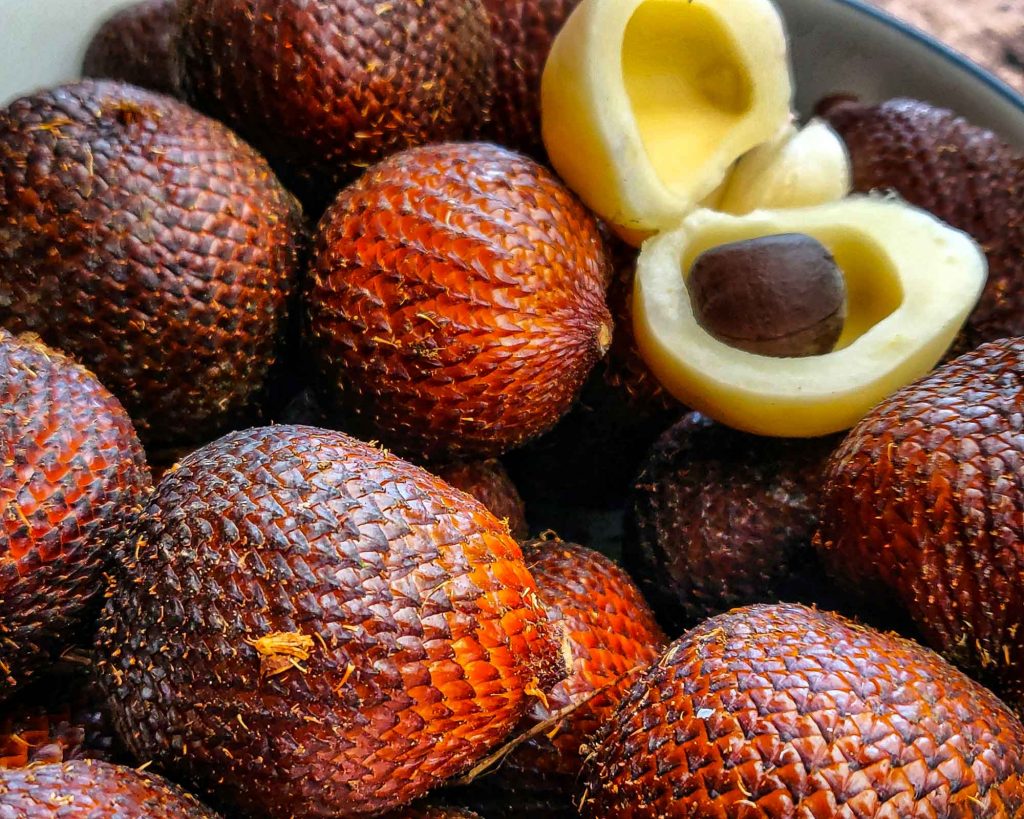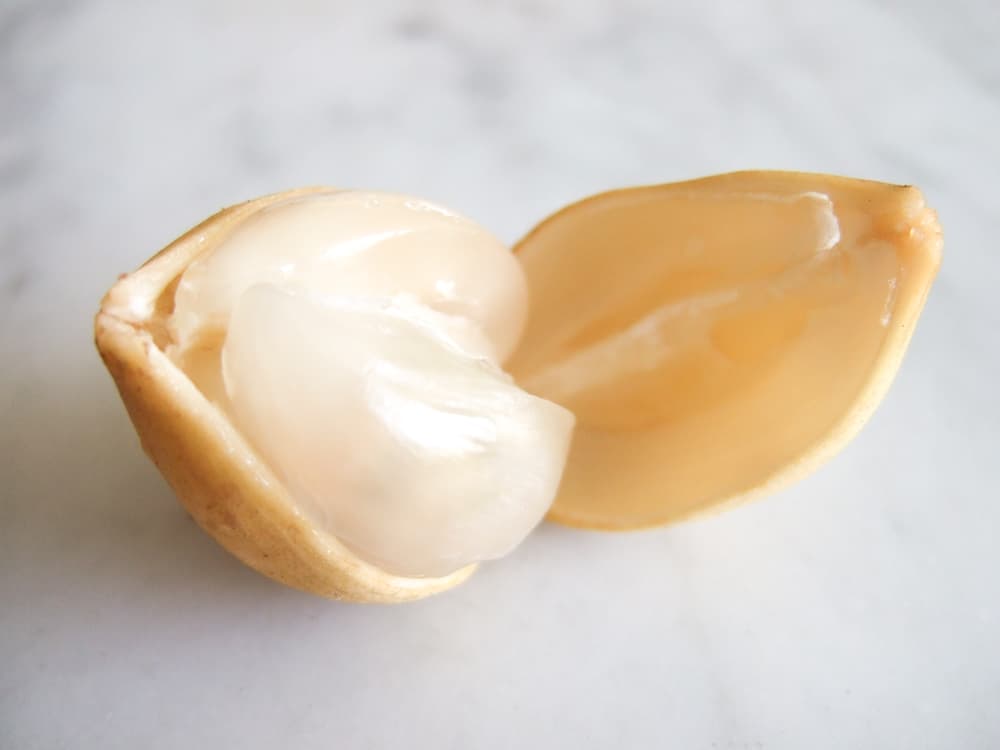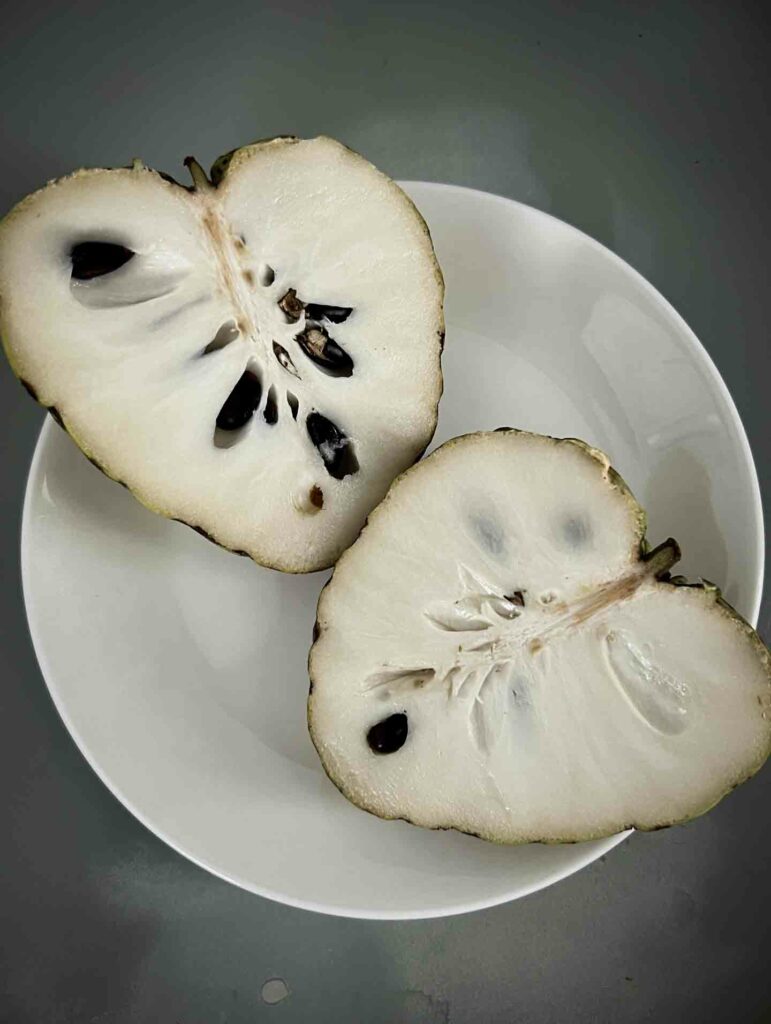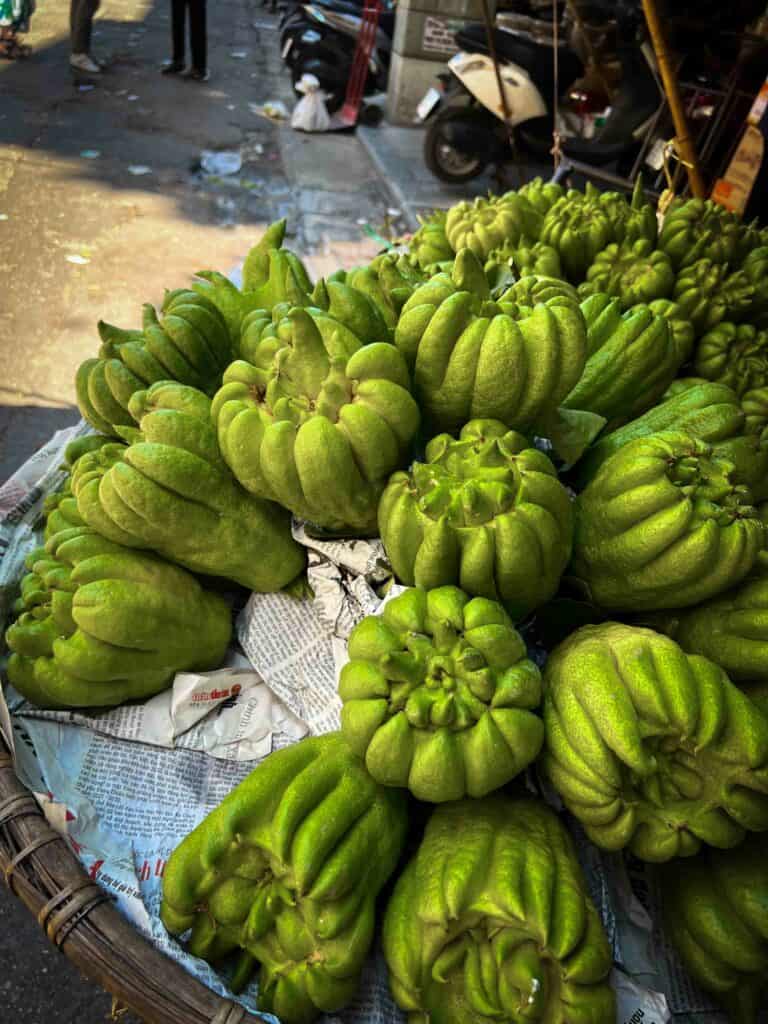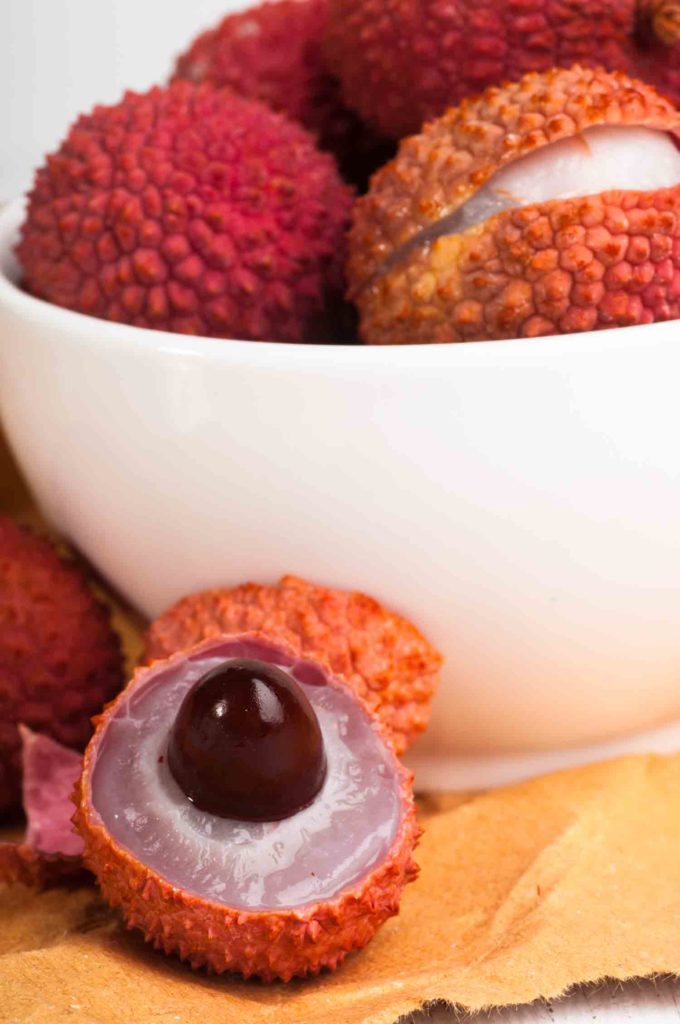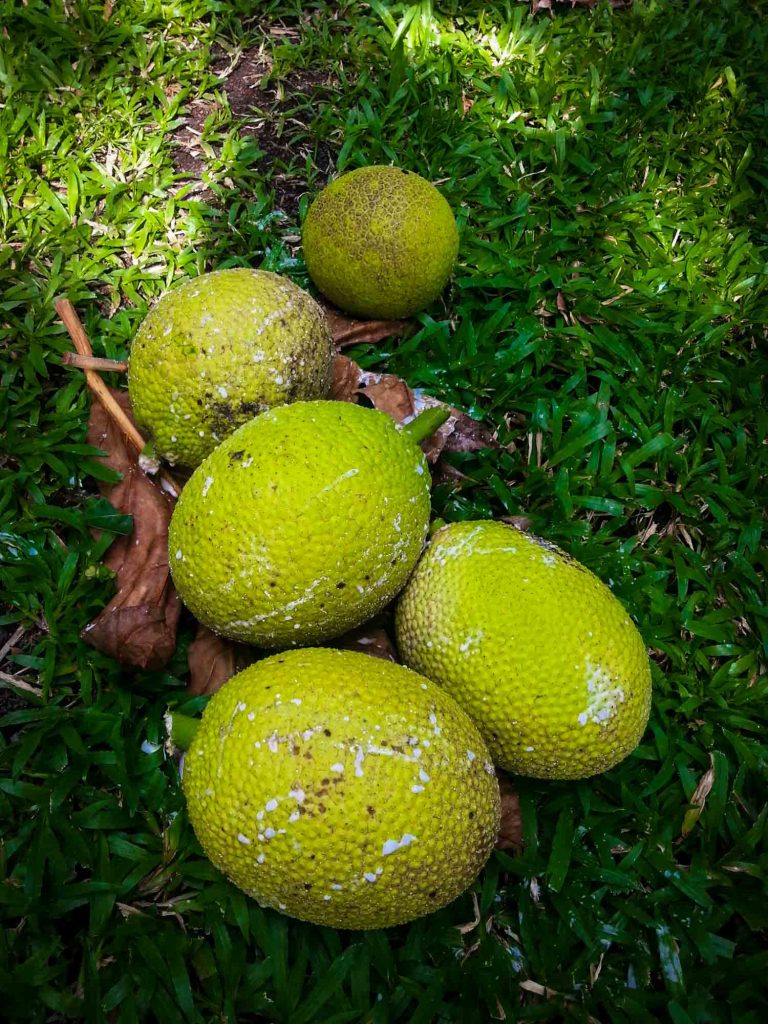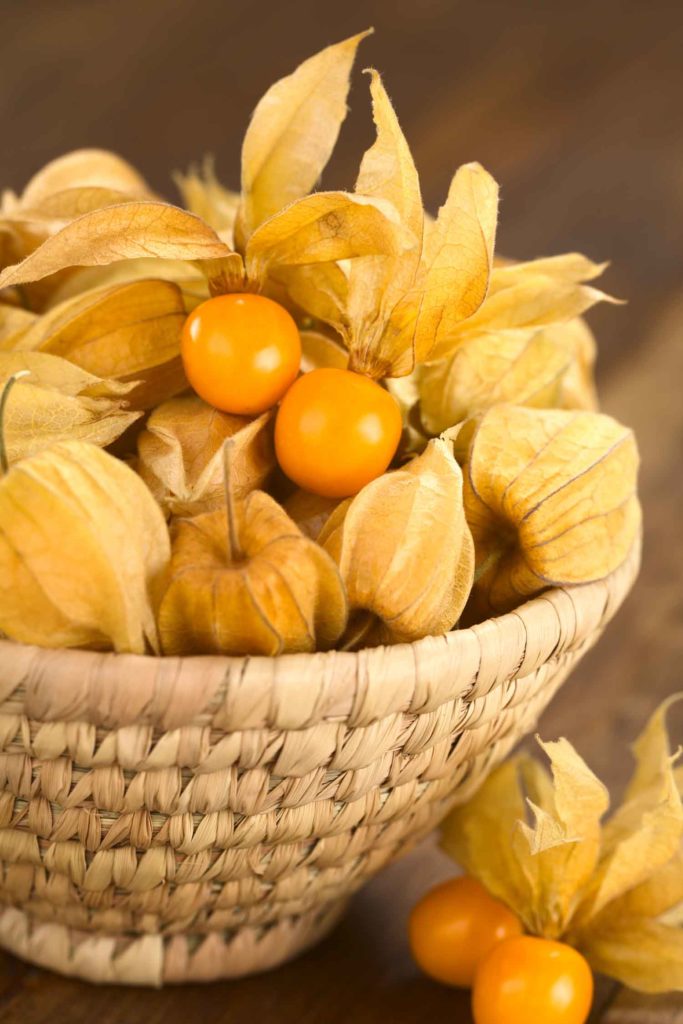Although many Thai fruit get exported around the world there’s nothing like eating them here.
I arrived in Thailand in October and I heard that it was “fruit season.” This surprised me because usually tropical fruits have several seasons in a year. And many fruits can be harvested all year round.
I didn’t question it because I was eating so many delicious, sweet exotic fruit and it did seem like peak season!
Most Exotic Fruits Around the World
Thai Fruit Season
Most Thailand fruits are in season May-September.
I arrived in mid-October to find lots of fruit still in season. After all fruit trees don’t close up shop just because it’s October 1st.
But the truth is fruits in Thailand are available all year round, although not all are available you’ll find plenty to eat.
33 THAI FRUITS YOU’LL LOVE
If you like to plan your holiday around specific fruit to try here are 33 of the best fruit in Thailand and when they are in season.
Mangosteen – มังคุด (mang-kut)
The national fruit of Thailand is Mangosteen and it is also known as the Queen of Fruits.
It’s beloved around the world and known as the mangostino fruit in Colombia and manggis fruits in Bali.
This small, round fruit has a hard purple shell and a sweet, tangy flavor.
It can be intimidating for westerners as they don’t know how to open the rugged exterior. But simply squash it between your hands and peel to reveal the pods.
But don’t bite in as they have a seed. Like a lychee or rambutan put it in your mouth and suck off the flesh.
It’s worth the effort. There’s a reason it’s the national fruit.
Scientific Name: Garcinia mangostana
Nutritional Benefits: Mangosteen is high in antioxidants, vitamin C, and fiber.
Mangosteen Season in Thailand: May to September
Santol – กระท้อน (kra-thon)
Santol is known as wild mangosteen and looks more like a peach, but has the same tough rind that a regular mangosteen has.
This Thai fruit is round, yellow with a thick, fibrous rind and a sweet, tangy interior.
It has a creamy sweet flavor that is just a bit tart, almost like a peach. It is not easy to find this fruit in Thailand so if you see it, grab it!
But if you miss it you can also find this fruit in Laos and it’s a common Cambodian fruit.
Scientific Name: Sandoricum koetjape
Other Common Names: Wild mangosteen
Nutritional Benefits: Santol is high in vitamin C, potassium, and fiber.
Santol Season in Thailand: May to September
Durian – ทุเรียน (thu-rian)
If we start with the Queen we also must mention the King of Fruits in Thailand. Durian is a large, spiky fruit with a creamy texture and a strong, pungent odor.
The odor is so strong in many countries in South East Asia there are signs indicating you can’t enter the building with it.
I’ve tried durian many times and find the yellow ones are more fruity than the white. And actually Thai durians are my favourite so far.
My advice is if you don’t like one keep trying. There are many varieties of durian, just like apples. And every country is a bit different.
Scientific Name: Durio zibethinus L
Nutritional Benefits: Durian is high in vitamin C, potassium, and fiber.
Durian Season in Thailand: May to September.
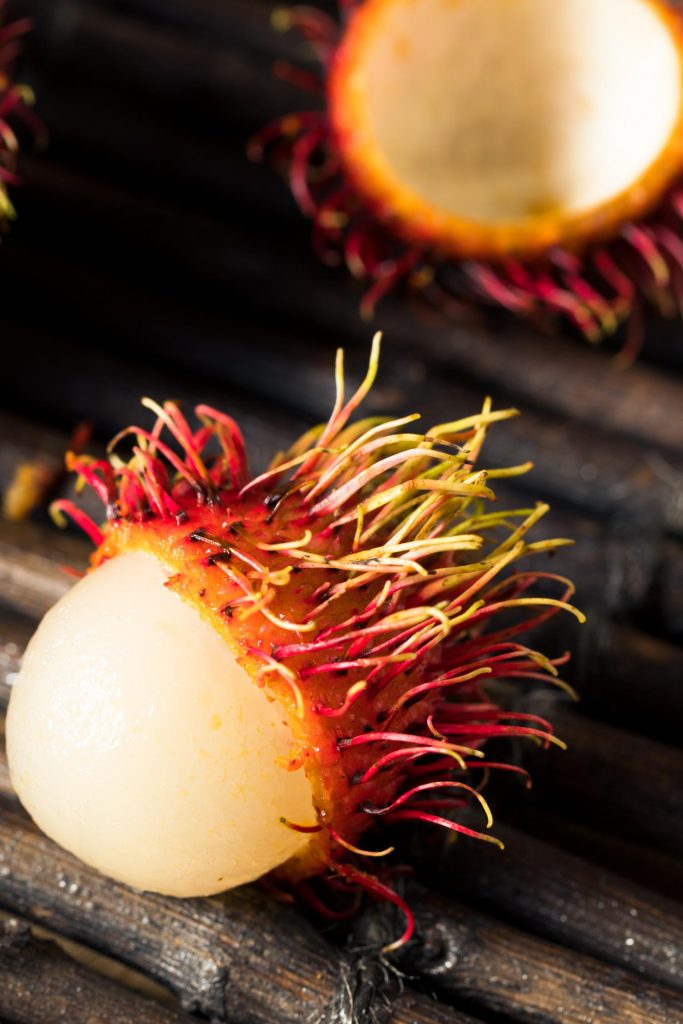
Rambutan – เงาะ (ngaw)
Rambutan is a small, red fruit with a spiky exterior and a sweet, juicy interior.
It is eaten fresh and usually sold on branches. But once cut the Thai fruits no longer ripen so it’s best to look for bright red juicy fruit.
You can find rambutan all over the world, even as far as Central America where they are a popular fruit in Guatemala known by the same name.
Scientific Name: Nephelium lappaceum
Nutritional Benefits: Rambutan is high in vitamin C, iron, and calcium.
Season in Thailand: May to September
Longan – ลำไย (lam-yai)
Longan is a small, round fruit with a thin, brown shell and a sweet, juicy interior. It is eaten fresh and again fruits in Thailand often sold in markets on their branches.
Scientific Name: Dimocarpus longan
Other Common Names: Dragon’s Eye
Nutritional Benefits: Longan is high in vitamin C, potassium, and magnesium.
Longan Season in Thailand: May to September
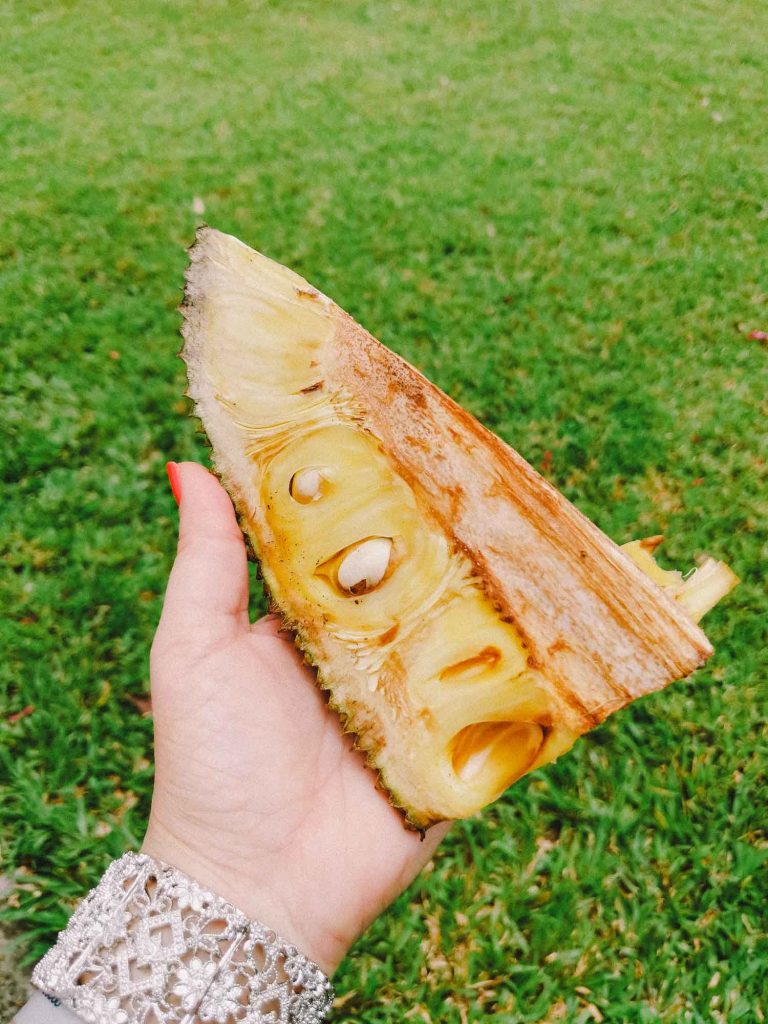
Jackfruit – ขนุน (ka-nun)
Jackfruit is a large, green or yellow fruit with a spiky exterior and a sweet, fleshy interior filled with large seeds.
It looks like a giant durian. Usually it will be cut into manageable pieces at the market as it is so large,
It is very sweet like a fruit cocktail when fresh. But it is also popular in savory dishes and common replaces “pulled pork” in vegan dishes.
It’s used in many traditional foods in Chiang Mai including kaeng khanun curry with unripe jackfruit and tam kanun spicy salad with young jackfruit.
It’s so popular you can even get it in 7-11 but it’s not as good as when sold in the market.
Scientific Name: Artocarpus heterophyllus
Other Common Names: jak, jaca, khanun, khnor, maki mi, may mi, and mit, nangka, yaca
Nutritional Benefits: Jackfruit is high in vitamin C, potassium, and fiber.
Jackfruit Season in Thailand: July to October
Pomelo – ส้มโอ (som-o)
Pomelo is a large, green fruit with a thick, spongy skin and a sweet, tangy flavor.
It’s similar, but not the same as a grapefruit nor as bitter.. And it’s quite large, and can be the size of a volleyball.
For this reason many fruit markets in Thailand will break it down into portions that are ready to eat.
Scientific Name: Citrus maximus
Other Common Names: Citrus-maxima, citrus grandis, citrus decumana, shaddock, pummelo
Nutritional Benefits: Pomelo is high in vitamin C, potassium and fiber.
Pomelo Season in Thailand: November to March
Popular Chiang Rai Foods
Thai White Guava – ฝรั่ง (farang)
Guava is a small, round fruit with a green or yellow skin and a sweet, juicy interior.
It is eaten fresh or used in desserts and drinks.
Although many people are accustomed to the soft pink interior of guavas like the Peruvian fruit variety.
But the white guava in Thailand is crunchy with a white or light green interior.
Scientific Name: Psidium guajava
Other Common Names: Guayaba
Nutritional Benefits: Guava is high in vitamin C, potassium, and fiber.
Guava Season in Thailand: May to September
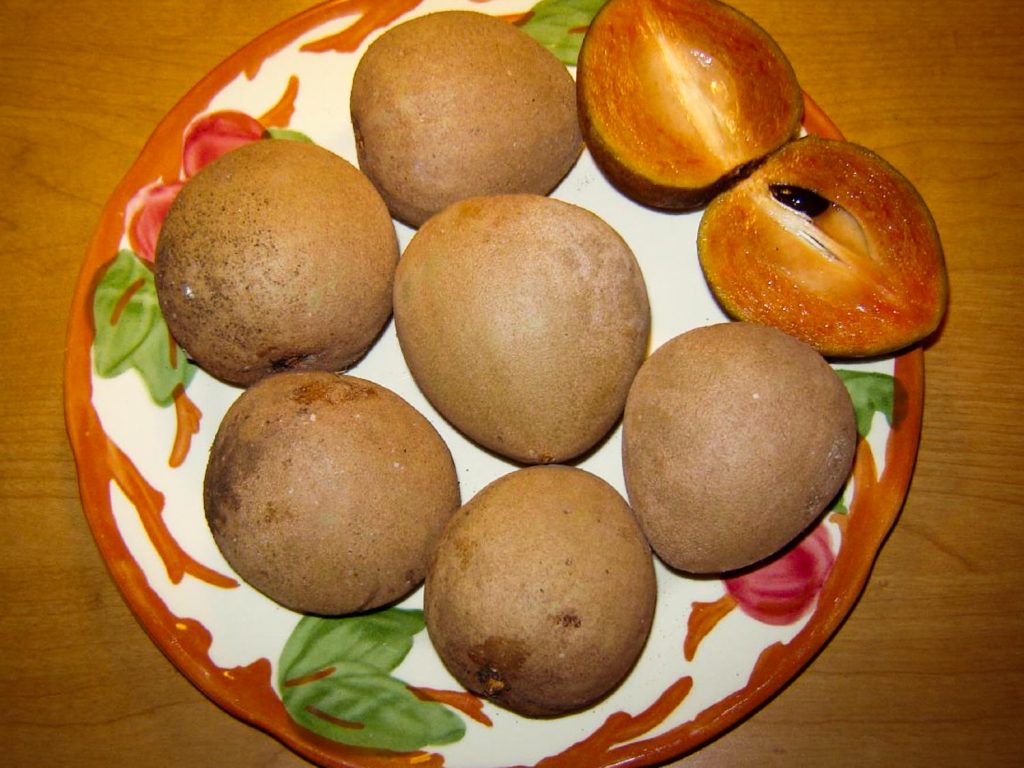
Sapodilla – ละมุด (lam-ud)
Sapodilla is a small, brown fruit with a sweet, caramel-like flavor and a fleshy interior. It is eaten fresh and is a common fruit in Thailand but also Latin America.
It is one of my favourites because it doesn’t have a sweet fruit taste. I first had this Thailand fruit in Mexico and was blown away.
It is like an apple pie cooked in brown sugar and molasses. It seems strange at first but worth trying.
Scientific Name: Manilkara zapota
Other Common Names: chicozapote, chicoo, chicle, naseberry, nispero, sapodilla sapote, soapapple
Nutritional Benefits: May to September
Sapodilla Season in Thailand: Sapodilla is high in vitamin C, potassium, and fiber.
Black sapote – ลำไยดำ (lam-yai dam)
Black sapote is a green or brown fruit with a soft, custard-like flesh and a few large seeds. These Thai fruits are eaten fresh or used in desserts.
Similar to sapodilla the taste is surprising and so is the texture. They can be quite soft when ripe and taste like a sweet caramel pudding.
Scientific Name: Diospyros nigra
Other Common Names: Black persimmon, chocolate pudding fruit
Nutritional Benefits: Black sapote is high in vitamin C, fiber, and antioxidants.
Black Sapote Season in Thailand: October to December
Makok or Mombins – มะกอก (ma-gok)
Makok is a small, round fruit with a hard, green shell and a sweet, juicy interior.
They are sour so they can be eaten raw but often turned into jams and jellies. And they are also fed to pigs in many countries which is why they are also called hog plums.
Scientific Name: Spondias pinnata
Other Common Names: Hog plum, Java plum, kedondong in Indonesia
Nutritional Benefits: Makok is high in vitamin C, potassium, and fiber.
Makok Season in Thailand: May to September
Mangaba – มังคะบาว (mang-kabaow)
Mangaba is a round, yellow fruit with a thick, fibrous rind and a sweet, juicy interior filled with seeds. It is eaten fresh.
Mangaba is not a native fruit of Thailand. These are popular Brazilian fruits, where they are widely grown and consumed.
It is grown in Thailand as a tropical fruit, but it is not as widely available as it is difficult to grow.
The tree is also used for a type of latex in Brazil and so to ensure the fruit doesn’t have any rubbery kind of flavour it needs to be so ripe it almost falls to the ground.
Scientific Name: Hancornia speciosa
Nutritional Benefits: Mangaba is high in vitamin C, potassium, and fiber.
Mangaba Season in Thailand: June to August
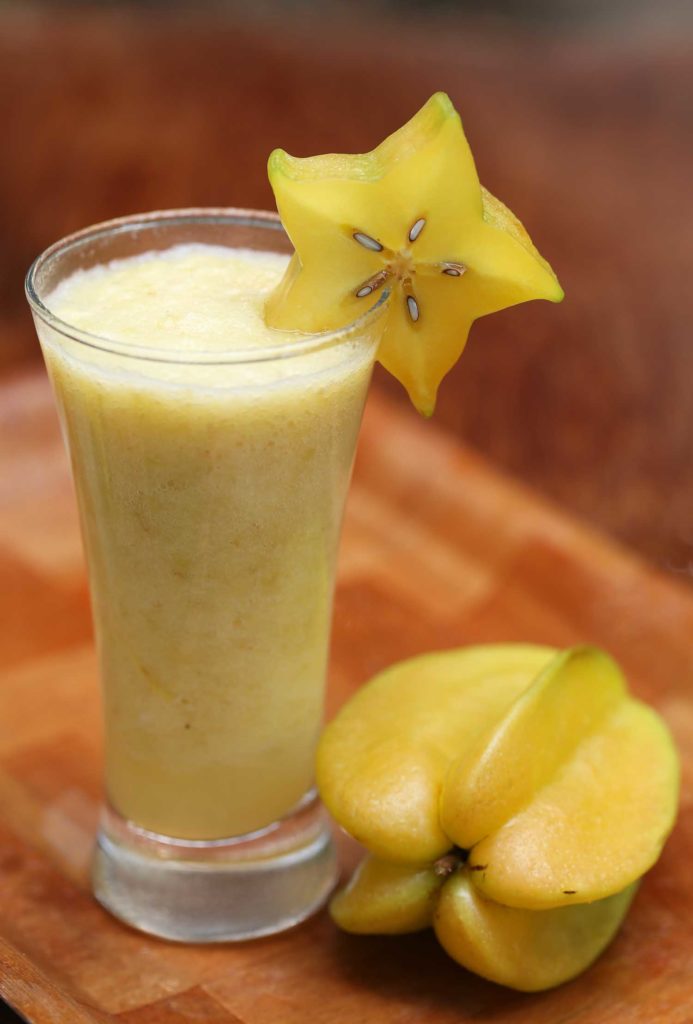
Starfruit – มะเฟือง (ma-feuang)
Starfruit is a small, yellow fruit with a star-shaped cross-section and a sweet, tangy flavor.
It is eaten fresh and in drinks but is very tart so often combined with sugar. It’s one of the most popular fruits in Costa Rica, a country with a similar tropical climate.
Scientific Name: Averrhoa carambola
Other Common Names: Carambola
Nutritional Benefits: Star fruit is high in vitamin C, potassium, and fiber.
Starfruit Season in Thailand: May to September
Kaffir lime – มะกรูด (ma-krut)
Kaffir lime is a small, green fruit with a tart, tangy flavor and a fragrant peel. It is used in savory dishes and is available year-round.
The term “kaffir” is considered a derogatory and offensive term in many parts of the world, especially in South Africa, where it was used as a racial slur against black people during the apartheid era.
In Thailand, the term “kaffir lime” is still used to refer to the fruit, but it is important to note that the term is not used as a racial slur in Thai language or culture.
However, due to the negative connotations associated with the term in other parts of the world, some people prefer to use alternative names for the fruit, such as “makrut lime” or “Thai lime.”
Scientific Name: Citrus hystrix
Other Common Names: Makrut lime, K Lime,
Nutritional Benefits: Kaffir lime is high in vitamin C, calcium, and potassium.
Kaffir Lime Season in Thailand: All year round.
Dragon fruit – แก้วมังกร (kaew-mang-kon)
Dragon fruit is a large, red or yellow fruit with a white, juicy interior and black seeds.
It is eaten fresh and common in juices in Thailand.
I must admit I never liked dragonfruit until eating it in South East Asia. In Canada it tastes so bland and so I thought it was a pretty fruit with no taste.
Although it was also one of my favourite Ecuadorian fruits, so maybe the problem is exporting it to Canada.
Dragonfruit from Thailand tastes like a fresh kiwi pear mix and definitely worth eating.
Scientific Name: Selenicereus undatus
Other Common Names: Pitaya or pitahaya
Nutritional Benefits: Dragon fruit is high in vitamin C, iron, and fiber.
Dragonfruit Season in Thailand: May to September
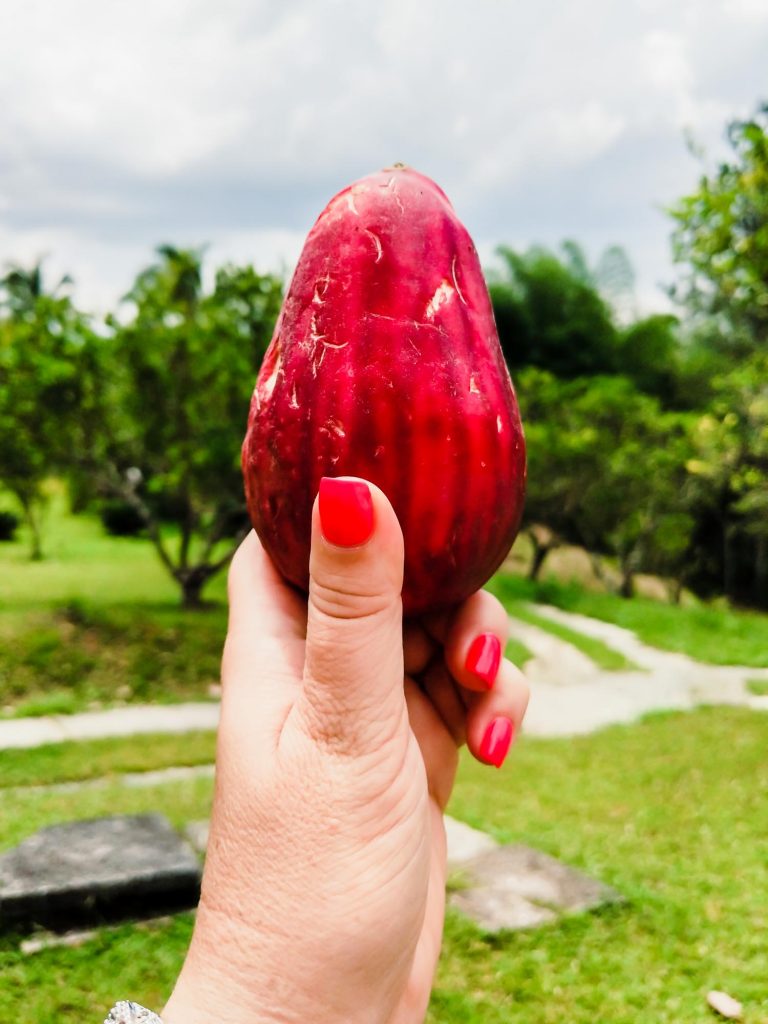
Rose apple – ชมพู่ (chom-phu)
Rose apple is a small, round fruit with a pink or green skin and a crisp, juicy interior.
I first discovered rose apple on a Jamaican fruits tour where they call it Otaheite (pronounced O-Tahiti) apple or Malay rose apple, mountain apple, coco plum and Ethiopia apple.
It looks like an apple but feels more like a spongy fleshed pear and is full of refreshing fruit juice.
Scientific Name: Syzygium jambos
Other Common Names: ,Jambu air mawar, jambu mawar, jambu kraton, jambu kelampok, jambu mawer, malabar plum
Nutritional Benefits: Rose apple is high in vitamin C, potassium, and calcium.
Rose Apple Season in Thailand: May to September
Tamarind – มะขาม (ma-kham)
Tamarind is a small, brown fruit with a sour, tangy flavor and a sticky pulp.
It is used in savory dishes and popular in fish dishes in the south influenced by Malaysia and Indonesian cuisine.
Tamarind is also a popular ingredient in Latin American cuisine and is a commonly used Nicaraguan fruit.
Scientific Name: Tamarindus indica
Other Common Names: asam, asam jawa, Indian date, tamarindo
Nutritional Benefits: Tamarind is high in vitamin C, potassium, and iron.
Tamarind Season in Thailand: May to September
Snakefruit – สละ (sa-lar)
Salak is a small, brown fruit with a scaly exterior and a sweet, tangy flavor. It is eaten fresh and tastes like a mix of strawberry, kiwi, banana.
To eat simply pick of the scaly skin and bite around the pit.
Salak is originally an Indonesian and Malaysian fruit but can be found today as far as the Amazon in Ecuador.
Scientific Name: Salacca zalacca
Other Common Names: luk rakam, rakum palm fruit, ridan, salak
Nutritional Benefits: Snakefruit is high in vitamin C, potassium, and fiber.
Snakefruit Season in Thailand: May to September
Longkong – ลองกอง (long-gong)
Longkong is a small, round fruit with a thin, yellow skin and a sweet, juicy interior.
It’s unique to South East Asia and common in Malaysia, Thailand, Philippines and is one of the most popular Indonesian fruits.
If it’s a good ripe langsat the flavour is like a grape lychee.
Similar to a lychee or rambutan you remove the skin and suck the sweet flesh off the pit.
Scientific Name: Lansium domesticum
Other Common Names: duku, langsat, lanzones
Nutritional Benefits: Langsat is high in vitamin C, potassium, and fiber.
Longkong Season in Thailand: May to September
Mango – มะม่วง (ma-muang)
Mango is a large, yellow fruit with a sweet, juicy interior and a large, flat seed.
In Thailand you’ll find mangos used as both sweet fruit and in sour, unripe preparations.
While there are many kinds of mangoes they are usually varieties of two distinct genetic populations known as either Indian or South East Asian.
Scientific Name: Mangifera indica
Nutritional Benefits: Mango is high in vitamin C, vitamin A, and fiber.
Mango Season in Thailand: February to end of July
Custard apple – น้อยหน่า (noi-na)
Custard apple is a large, green fruit with a sweet, creamy interior and large black seeds.
Mark Twain once said it is the most delicious fruit known to man. It tastes like a combination of pineapple and banana. It is fantastic eaten raw, as slices or in a smoothie.
Many cultures believe in its healing properties. These fruits in Thailand have cytotoxins many people think combat everything from malaria to cancer.
Outside South East Asia it’s common throughout Latin America and a beloved Cuban fruit and Chilean fruit.
Scientific Name: Annona squamosa
Other Common Names: Atis, cherimoya, sweetsop, sugar apple
Nutritional Benefits: Custard apple is high in vitamin C, potassium, and fiber.
Custard Apple Season in Thailand: May to September
Watermelon – แตงโม (taeng-mo)
Thai watermelon are one of the most refreshing ways to cool down on a hot day.
Street vendors have plenty on ice and if you’re lucky you can choose between the traditional red and the exotic yellow variety.
Scientific Name: Citrullus lanatus
Nutritional Benefits: Watermelon is high in vitamin C, potassium, and fiber.
Watermelon Season in Thailand: All year round.
Buddha’s hand – มะกรูดฝรั่ง (ma-krut farang)
Buddha’s hand is a fragrant, finger-like fruit with a yellow skin and no pulp or juice. The rind or fruit zest is most commonly used.
Natural medicine doctors in Thailand have used the peel of the Thai fruit for a variety of purposes and much of its medical properties have been confirmed by formal research.
A fun fact is that it is one of the most popular Vietnam fruits although no one ever eats it.
It would be considered disrespectful to Buddha so instead it’s an offering on the alter.
Scientific Name: Citrus medica var. sarcodactylis
Other Common Names: Fingered citron
Nutritional Benefits: Buddha’s hand is high in vitamin C, antioxidants, and fiber.
Buddha’s Hands Season in Thailand: October to December.
Coconut – มะพร้าว (ma-prao)
Coconut is a large, brown fruit with a hard, fibrous exterior and a white, juicy interior. It is eaten fresh or used in savory dishes and is available year-round.
In southern Thailand coconuts are a great way to beat the heat and replenish electrolytes.
Coconut milk is also a common ingredient in curries here as cuisine has been influenced by neighbouring Malaysia and Indonesia.
Scientific Name: Citrus medica var. sarcodactylis
Nutritional Benefits: Coconut is high in fiber, iron, and potassium.
Coconut Season in Thailand: All year round.
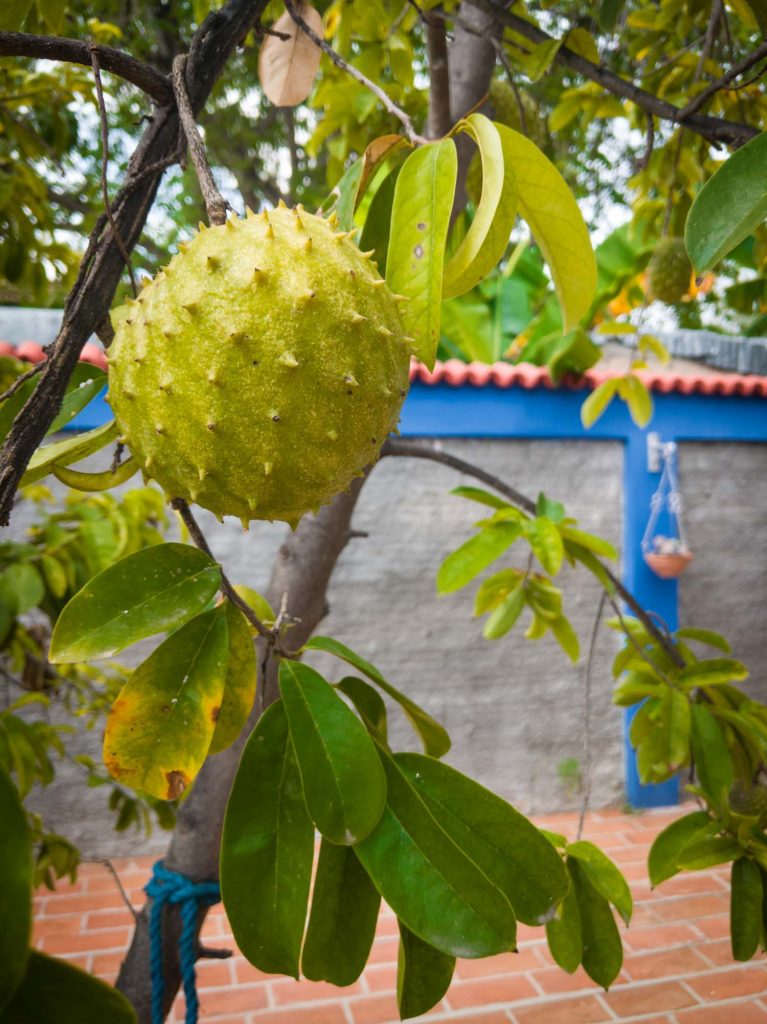
Soursop – ทุเรียนไทย (thu-rian thai)
Soursop is a green, spiky fruit with a creamy, white interior filled with black seeds. It is eaten fresh or used in desserts.
It kind of looks like durian but isn’t stinky at all. Instead soursop tastes like a fruit cocktail of pear, banana and strawberry.
Many people around the world believe it is a super fruit with cancer curing properties
It is originally from Central America and is a common throughout Latin America and it’s a popular fruit in the Philippines.
Scientific Name: Annona muricata
Other Common Names: Guanabana, guayabano, graviola, Brazilian paw paw
Nutritional Benefits: Soursop is high in vitamin C, fiber, and antioxidants.
Soursop Season in Thailand: June to August
Lychee – ลิ้นจี่ (lin-chi)
Lychee is a small, round fruit with a rough, red exterior and a sweet, juicy interior.
To eat just pinch the fruit to break the skin and pop it into your mouth. Suck the sweet fruit off the pit, which is about the size of an almond.
Lychees have a bright flavour almost like strawberry and pear, which is why they are so common in desserts and even cocktails.
Scientific Name: Litchi chinensis
Nutritional Benefits: Lychee is high in vitamin C, potassium and fiber.
Lychee Season in Thailand: March to May
Breadfruit – ปลาร้า (pla-ra)
Breadfruit is a large, green fruit with a starchy, bread-like interior. It is a healthy starch alternative and can grow well in places close to the equator.
I first discovered breadfruit on Maui where it is known as ulu.
When overripe it is like a delicious fruit pudding, but when ripe it can be used to replace starch for a low glycemic alterative.
You can bake, fry and cook this Thailand fruit. It can be used as a substitute for potatoes, yuca and other tubers.
Scientific Name: Artocarpus altilis
Other Common Names: buen pan, jeev kadge phodi, kadachakka varuthath, kamansi, masapan, kamansi, panapén, pana
Nutritional Benefits: Breadfruit is high in fiber, vitamin C, and potassium.
Breadfruit Season in Thailand: June to August
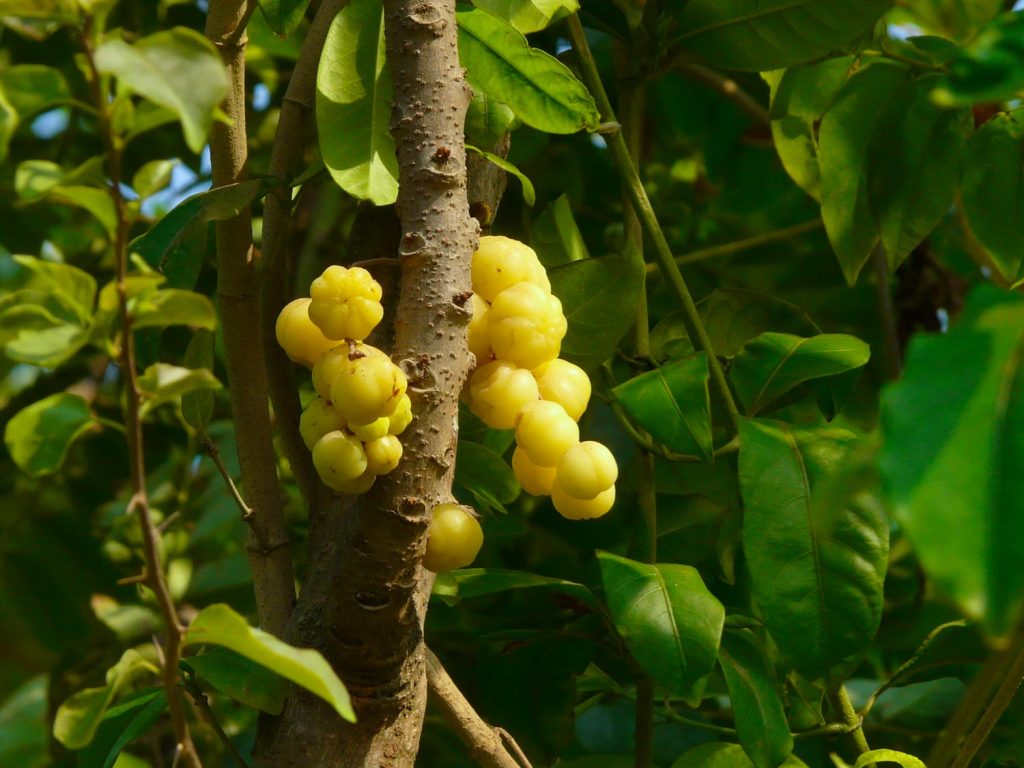
Star Gooseberry – มะยม (ma yohm)
Star gooseberry is a small, green fruit with a tart, tangy flavor and a juicy interior.
Although the name is gooseberry it doesn’t actually taste like one. However it is tart and a bit sour.
Because of these flavors it is used in som tam, ma-yom chuam and often picked or boiled.
This is also a common fruit in Trinidad and Tobago, known as sour cherry and often cooked with ginger and sugar in a stew.
Scientific Name: Phyllanthus acidus
Other Common Names: arbari, grosella, Malay gooseberry, Otaheite gooseberry, starberry, Tahitian gooseberry, West India gooseberry
Nutritional Benefits: Star gooseberry is high in vitamin C, iron, and calcium.
Star Gooseberry Season in Thailand: January
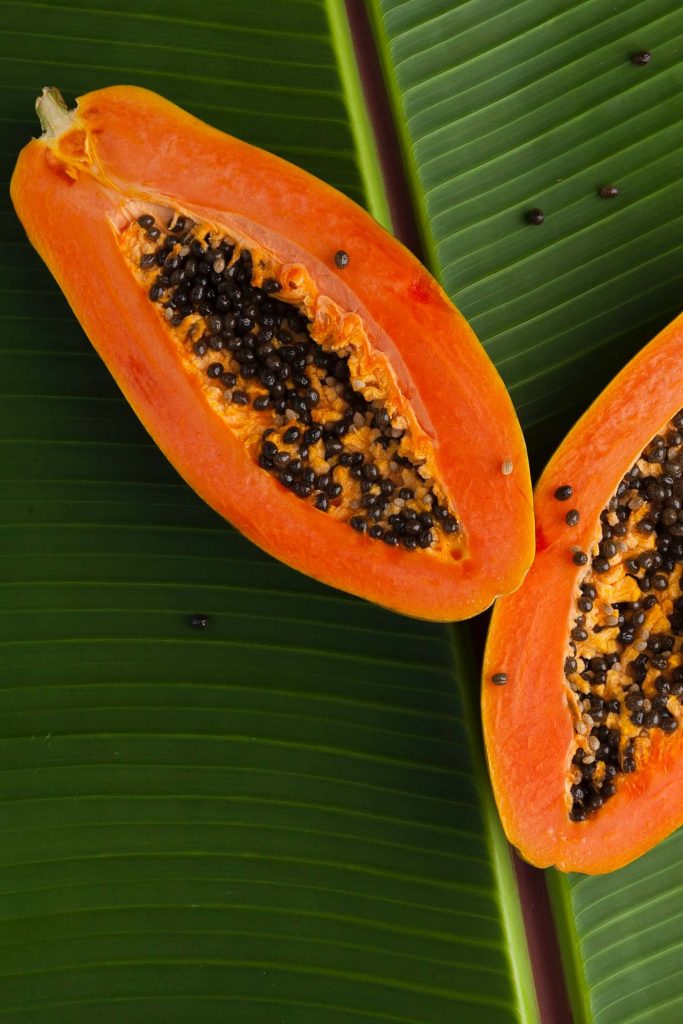
Papaya – มะละกอ (ma-la-gor)
Papaya is a large, orange fruit with a sweet, juicy interior and black seeds. It is eaten fresh and often the main ingredient in Thai salads such as som tum.
Papaya is found in most tropical climates from South East Asia all the way to Central America where it is a popular fruit in Panama.
Scientific Name: Carica papaya
Other Common Names: Fruta bomba
Nutritional Benefits: Papaya is high in vitamin C, potassium, and fiber.
Season in Thailand: All year round.
Banana – กล้วย (kluai)
Tourists often snub their nose at the banana because they can eat it at home.
But there is nothing like eating a banana in the country it was grown. And these Thailand fruits are proof of it.
The plain Cavendish variety you have at home will have so much more flavor. But step it up and also try the baby bananas which are often too fragile to be exported.
They will make you rethink the lowly banana status.
Scientific Name: Musa
Nutritional Benefits: Banana is high in vitamin C, potassium and fiber.
Banana Season in Thailand: All Year Round
Golden berry – โทงเทงฝรั่ง
Golden berry is a small, yellow fruit with a papery husk and a sweet, tart flavor.
It is eaten fresh and used in desserts. It is original from South America and often called Peruvian ground cherry or aguaymanto fruit in Argentina.
Scientific Name: Physalis peruviana
Other Common Names: Peruvian ground cherry
Nutritional Benefits: Golden berry is high in vitamin C, antioxidants, and fiber.
Golden Berry Season in Thailand: May to August
21 AWESOME: South American Fruits
Tangerine – ส้มเขียวหวาน (som-khiew-wan)
Tangerine is a small, orange fruit with a thin, easy-to-peel skin and a sweet, juicy interior. It’s popular because it’s easy to peel and smaller than a regular orange.
Scientific Name: Citrus reticulata
Other Common Names: Mandarin orange
Nutritional Benefits: Tangerine is high in vitamin C, folate, and fiber.
Tangerine Season in Thailand: November to January
Phuket pineapple – สัปปะรดภูเก็ต (sap-parot-phuket)
Phuket pineapple, or “สัปปะรดภูเก็ต” in Thai, is a type of pineapple that is native to the Phuket province in southern Thailand.
This Southern Thailand fruit is small, yellow with a sweet, juicy interior and a fragrant aroma.
Compared to regular pineapple, Phuket pineapple is smaller in size and has a rounder shape.
The skin of Phuket pineapple is also thinner and smoother than regular pineapple, and the flesh is more yellow in color.
Phuket pineapple is generally considered to be sweeter and less acidic than regular pineapple, and it is often used in desserts and smoothies in Thailand.
Although Hawaii is famous for pineapple, if you like the sweetness of this fruit in Hawaii you’ll also like the fruits from Thailand.
Scientific Name: Ananas comosus
Nutritional Benefits: Phuket pineapple is high in vitamin C, manganese, and fiber.
Pineapple Season in Thailand: May to September
